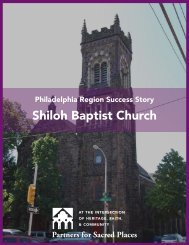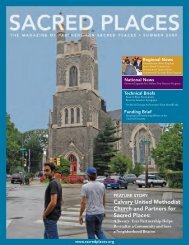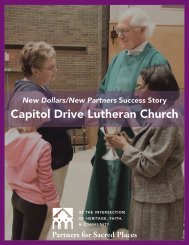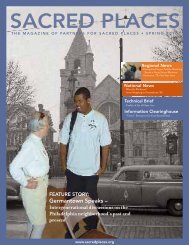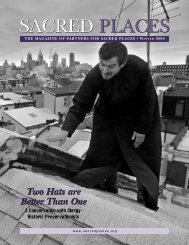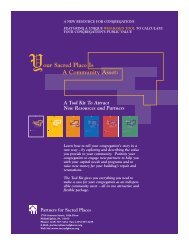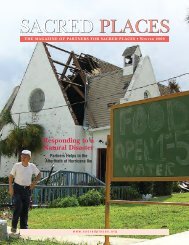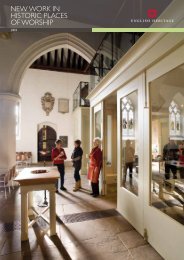FEATURE STORY - Partners for Sacred Places
FEATURE STORY - Partners for Sacred Places
FEATURE STORY - Partners for Sacred Places
Create successful ePaper yourself
Turn your PDF publications into a flip-book with our unique Google optimized e-Paper software.
RICHARD DRIEHAUS INTERVIEW (cont.)<br />
but…<br />
RD: In the 1970s, I wanted to open up a bar/restaurant in<br />
Chicago on the southwest side. I started collecting artifacts<br />
<strong>for</strong> that project like original posters, terra cotta, iron and<br />
glasswork, and woodwork. At the time, restaurants were<br />
changing from fern bars or big loft spaces, to Houlihan’s and<br />
Bennigan’s and T.G.I. Friday’s where they used architectural<br />
artifacts. These restaurants were larger and used more<br />
industrial/commercial art like railroad signs, or pub signs.<br />
I wanted to do something a little more upscale, more<br />
The Notre Dame nuns taught us that<br />
one of the things you had to do, if we<br />
were successful, was to give back. . . .<br />
By staying active in business and giving<br />
back, you can help people in the long<br />
term.<br />
decorative arts.<br />
GG: Which church did you attend as a child?<br />
RD: That was St. Margaret of Scotland.<br />
GG: It’s still open?<br />
RD: It’s still open; you should [see it].<br />
GG: Now, you went to school there too?<br />
RD: Yeah, I went to grammar school there at the church.<br />
High school…<br />
GG: You went to St. Ignatius, right?<br />
RD: Then I went to St. Ignatius, right. The church<br />
was important. Everyone knew their parishes. [The<br />
neighborhood was] split between St. Margaret and St.<br />
Kilian’s. But you know, if I were one street over, I’d be in<br />
another parish. It was pretty well defined. You could have<br />
been on Racine Street on one side, the west side, went to St.<br />
Margaret’s and the east side went to St. Kilian’s…which was<br />
a little closer by about a half a block. I’m more classicist and<br />
I’d like to keep it the way it was but how do you balance that<br />
since the ethnic populations have changed? How do you still<br />
keep the old sense of beauty and still have it relate today…<br />
GG: Yeah, that’s a challenge.<br />
RD: We should have a committee on aesthetics.<br />
GG: Let’s go to this beautiful story of Calvary United<br />
Methodist Church in Philadelphia. Do you remember this<br />
story, Mr. Driehaus?<br />
RD: I do. We bought these windows and then I found out<br />
they’re from this church. There was an article in a small art<br />
or antique magazine and then we gave them back. It was a<br />
great location, just an older location.<br />
GG: They host five different types of congregations there<br />
now.<br />
RD: Oh, that’s great.<br />
GG: It is one of our poster-child types of stories.<br />
RD: That’s terrific!<br />
GG: We advocate multiple uses of older buildings with<br />
shrinking congregations.<br />
RD: So how to use it more culturally like they do in Prague or<br />
something…<br />
GG: Exactly! And <strong>for</strong> theaters. And then the church has an<br />
effect on the neighborhood, because obviously people are<br />
going to see the show so a little café can open nearby, a little<br />
restaurant.<br />
RD: It’s more European – better use of your historic<br />
environment. Even though America is a young country, we<br />
still have churches, some of our most beautiful elements<br />
and built <strong>for</strong> our history. Hopefully we can continue to use<br />
them…<br />
If we don’t save them, we lose our sense of how we got here<br />
and what we did. Our history with our grandparents, our<br />
parents…we’re losing a connection to the past that will never<br />
be replaced. There are enough things separating us from our<br />
history that we need a physical sense of connection.<br />
GG: Any particular reason why you started to give back so<br />
much?<br />
RD: Well, it’s what we were taught. The Notre Dame nuns<br />
taught us that one of the things you had to do, if we were<br />
successful, was to give back. It sounded like a good idea!<br />
(laughing) If you let it all pile up like it’s fertilizer, it stinks<br />
and you don’t have any friends. And then people start to<br />
wonder why you are hoarding all that stuff. When you’re<br />
working on certain values and truths that work, it is easy to<br />
give. If you think of money like a river or resources, then it<br />
is much easier to give. You can be very, very wealthy but also<br />
paranoid. You might sell your company <strong>for</strong> a billion dollars,<br />
then what are you going to do? By staying active in business<br />
15 • <strong>Sacred</strong> <strong>Places</strong> • www.sacredplaces.org • Fall 2010




